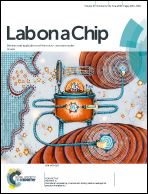Label-free, high-throughput detection of P. falciparum infection in sphered erythrocytes with digital holographic microscopy†
Abstract
Effective malaria treatment requires rapid and accurate diagnosis of infecting species and actual parasitemia. Despite the recent success of rapid tests, the analysis of thick and thin blood smears remains the gold standard for routine malaria diagnosis in endemic areas. For non-endemic regions, sample preparation and analysis of blood smears are an issue due to low microscopy expertise and few cases of imported malaria. Automation of microscopy results could be beneficial to quickly confirm suspected infections in such conditions. Here, we present a label-free, high-throughput method for early malaria detection with the potential to reduce inter-observer variation by reducing sample preparation and analysis effort. We used differential digital holographic microscopy in combination with two-dimensional hydrodynamic focusing for the label-free detection of P. falciparum infection in sphered erythrocytes, with a parasitemia detection limit of 0.01%. Moreover, the achieved differentiation of P. falciparum ring-, trophozoite- and schizont life cycle stages in synchronized cultures demonstrates the potential for future discrimination of even malaria species.



 Please wait while we load your content...
Please wait while we load your content...